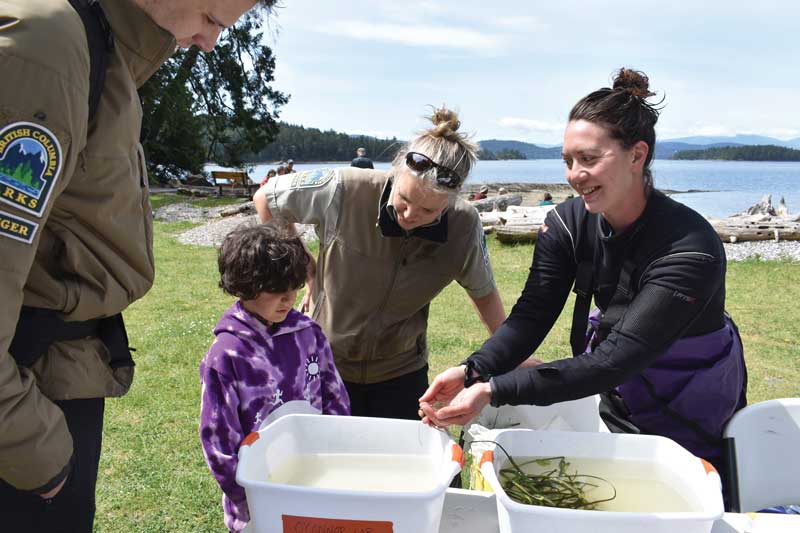Diving into a BioBlitz
By Heather Creech

One gorgeous spring weekend in May, the residents of two small islands in British Columbia got together for something more than coffee. Loaded up with cameras, notebooks, and sample bags, adults and school kids on Mayne and Galiano Islands spread out in order to document all the plants and wildlife across their islands. This was their first joint “bioblitz”—an event where people work together to add to the knowledge of local biodiversity and enrich their own appreciation of nature.
In an unusual step, the Mayne and Galiano Conservation Associations invited divers to join them. The divers were to seek out the life in the surrounding ocean while other participants climbed through forests, photographed birds, and spied into tidal pools.
Bioblitz in a Box
Bioblitzes are typically land-based events, following guidelines such as Bio-Blitz in a Box (www.bioblitzcanada.ca). But unfortunately, those guidelines are nearly silent on how to include a subtidal component that surveys what is happening in the near and offshore zone. Most suggest only that “for blitzes on the coast, consider inviting local diving clubs and marine societies”. The guidelines offer little else in the way of tools and methods for the marine component, and there are few examples out there of how organizations have included marine data gathering in a blitz. Mayne and Galiano were in somewhat uncharted territory, understanding that collecting subtidal data would have unique logistical, safety, and scientific challenges.
So why did they bother including the marine zones in their bioblitz? Organizers have suggested that a subtidal component has helped people better understand the full picture of the diversity in and around their community. And the collection of marine data can support scientific monitoring already taking place: as one organizer said, “The bioblitz has connected the marine scientific community more closely with local divers and the general public”.
Although challenging, the organizers believed tackling a full-scale blitz from the treetops to the reefs was worth it. A number of important lessons have been learned that may prove useful to others who want to get the bigger picture of the natural world around them:
Be clear on the purpose for the subtidal portion and how it fits with other bioblitz activities.
Solid objectives were established for the divers: to add to existing data sets about species within established marine conservation zones; to assess habitat; and to create a baseline of biodiversity as input to measures for protection against pollution. However, most bioblitzes also have an education component: this was not as clearly stated for the divers, although they were keen to show other participants what they were finding through photos and samples.
Plan well in advance for the event and have designated “leads” on the day.
The organizers prepared a thorough protocol for divers, outlining safety issues and emergency contacts, methods, sampling locations, and classifications to be used. Social media was used extensively to encourage divers to join in. In future, they may consider designating a “lead diver” to coordinate the rest of the diving group.
The survey methods should ensure that the data collected will be useful for science.
The organizers allowed considerable variation in data collection: on some sites, divers were to use a modified version of the REEF (Reef Environmental Education Foundation) roving diver methodology (which allows divers to explore a site freely, recording as many species as they can with their approximate abundances); other sites had pre-existing transects that the divers were to follow. One scientist felt that in future, a stronger experimental design behind the sampling effort might add to the validity to the data collected.
Know how you plan to analyze and use your data.
Both the Mayne Island and Galiano Island Conservancies hope to use the data for long-term monitoring. The organizers intend to compile the data sheets into a master species list and ensure that photos are uploaded to iNaturalist. More detailed analysis, however, is up in the air: if time and resources permit, a student will do some post processing and merge findings with their historical records.
If your coastal community is planning a bioblitz, encourage them to add a subtidal component. It will enrich the community’s understanding that local ecosystems don’t stop at the shoreline. And the exercise will provide data for tracking habitat and species over the long term, connecting what is happening on land with the vibrant life offshore.
Heather Creech is a citizen scientist with ReefWatch, dividing her time between Victoria, BC, and Adelaide, South Australia. To contact her: citizensciencereport@gmail.com







